Buy One If You Can Find One
If 2019 model-year cars have been arriving at dealer show rooms for the past six months, why am I reviewing the 2018 Toyota Prius c hybrid? Well, there are two reasons. First, the 2019 Prius c is unchanged and having its swan song. It’s being replaced by the all-new 2019 Corolla Hybrid, which has better fuel economy, is larger and costs about the same. Second, it’s cute as button and is my favorite hybrid city car, and this was my last chance to grab one for a test drive.
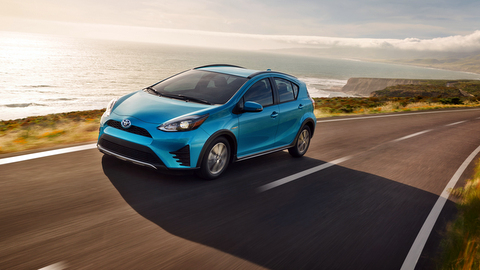
When introduced in March 2012, the Prius c sales began with a firestorm, chalking up 1,201 units sold within three days of its launch and 12,379 units in the first three months. The diminutive c was the fourth hybrid to be tagged a Prius and joined the conventional midsize Prius, the more spacious V (now discontinued) and the Prius Plug-in model (now the Prius Prime).
A starting price of $18,950 for the base model with a commendable list of standard features was not out of line with some other subcompacts. But with gas prices reaching $4.00 per gallon at the time, the attention grabber was the 48 mpg city/43 highway/46 combined fuel economy numbers.
The Prius c had commendable sales numbers for its first three years, then they began to slide. For 2018, sales were a sliver of their past as Toyota began its phase out of the car.
And just what does that “c” stand for? Cute, compact and cheap come to mind, but Toyota said it represented “city”; it was designed to function as an urban-friendly vehicle aimed at millennial buyers.
A Scaled Down Hybrid System
The basics of the 2018 Toyota Prius c’s hybrid system mirror those of the larger models, but everything is scaled down. The 1.5-liter four-cylinder Atkinson cycle engine is 0.3-liters smaller and its 73 horsepower is 25 less. Engine torque is also curtailed, 82 pounds-feet versus 105. Power output of the smaller electric motor, integrated into the continuously variable transmission (CVT) like it’s larger siblings, is 60 horsepower, down 20 horses, and torque production is also less, 125 pounds feet compared to 153 in the standard Prius. Total system output—engine and motor combined—is 99 horsepower for the Prius c, 35 fewer than its big brother.
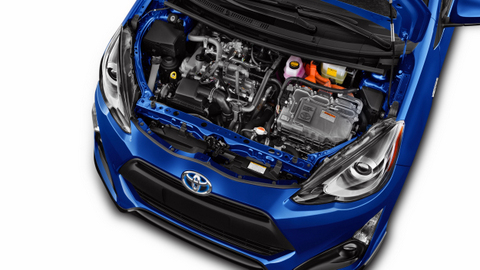
Like the other components, the nickel-metal-hydride battery is reduced in size and puts out fewer electrons. The battery pack consequently offers a modest 0.87 kilowatt-hours (kWh) hours rather than 1.2 kWh. Toyota positioned the battery pack and fuel tank beneath the rear seat. This placement not only provides additional cargo space, it furnishes a low center of gravity that enhances handling.
The Prius c’s hybrid system operates the same way as in other Prius models: it’s propelled by electric power alone for short distances up to around 35 mph; a combination of the engine and electric motor when more power is required; and engine only if the battery charge is low. The gas engine shuts off automatically when stopped and restarts when the brake pedal is released. Braking and coasting downhill recharge the battery.
Three distinct drive modes are offered—Normal, Eco and EV. Eco mode conserves fuel by governing the climate control and throttle response and EV mode allows the car to be driven on battery power alone for about one mile at up to 25 mph.
By Design, Doesn’t Look Like a Prius
Up front, the c does exhibit the familiar Prius nose bump with a Toyota logo badge below. However, the small upper grille opening is a slot rather than the elongated V shape with a chrome insert found on the larger models. And, although the headlamps on the c sweep upwards toward the front roof pillar, they look too large in proportion to the car’s size and aren’t as sleek as the other Prii.
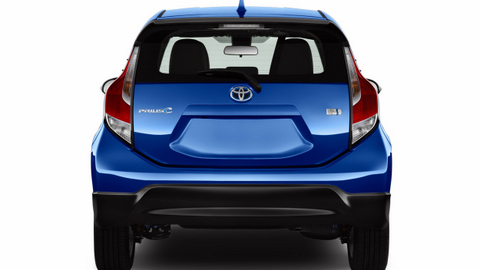
In profile, an angled hood seamlessly flows into a raked windshield, then to a curving roofline that meets up with a small rear spoiler. Adding a dash of boldness, large, sculpted rear wheel arches with a distinct character line swoop downward and taper toward the front. The backside is dominated by large vertical taillamps that are exclusive to the c.
The absence of Prius “hybridness” styling is by design. The mission was a look that would attract new, younger buyers that want a hybrid that didn’t shout, “Hey, look at me. I’m driving a hybrid.” The mission was accomplished with the c looking more like a Prius stepchild rather than a blood relative.
A Look Inside
Occupants are greeted with materials that are mostly hard plastic with a few soft-touch surfaces. This is expected in subcompact cars, but the quality appearance and feel lags behind others in the class. Trending towards hipness, the dash design, with an angled, asymmetric center console, is obviously aimed at young buyers. Overall, with its two-tone interior, the cabin presents a friendly, cheerful environment.
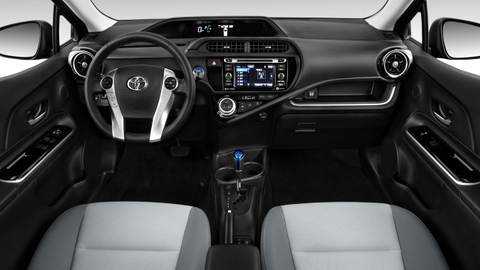
Like the grown-up standard Prius, the instrument panel is placed in the center of the dash below the windshield rather than the more orthodox—and easier to see—location behind the steering wheel. Readouts include the digital speedometer, fuel gauge, gear selection, odometer, average fuel economy and time.
One component not carried over from the other models is the stubby, confusing-to-use joystick gearshift lever positioned in the center console. The Prius c has a conventional floor-mounted shifter with the familiar PRND sequence, plus an ersatz low gear marked “B,” which slows the car and produces a more aggressive regenerative braking.
The 2018 Toyota Prius c has adequate room up front with good head- and legroom, and the bucket seats provide an agreeable blend of comfort and support. Entry and exit to the rear cabin can be somewhat difficult, but there’s sufficient legroom for above-average height folks, and there’s room for two adults or three little ones. With the rear seatbacks up there is an admirable 17.1 cubic feet of cargo room. The 60/40 split rear seat does fold to expand cargo space.
Features and Tech
The Toyota Prius c is offered in two trim level models for 2019—L and LE. Ensuring the c connects with the ever more connected young crowd, both versions come standard with an AM/FM CD audio system with MP3/WMA, an auxiliary audio jack, a USB port with iPod jack, hands-free phone and phone book access plus music streaming via Bluetooth connectivity.
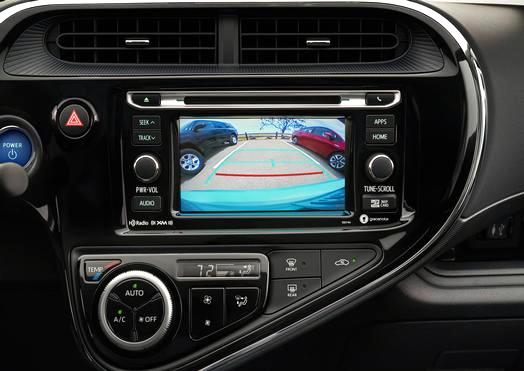
The entry Prius c L ($21,530 in 2019) has an arms-length list of standard features including power windows and locks, automatic climate control, intermittent front and rear wipers, a tilt/telescoping steering wheel with controls, remote keyless entry and hill start assist, which prevents rollback on hills when you let off the brake pedal. It includes nine airbags and the suite of Toyota Safety Sense C package of advanced technology (a pre-collision system with pedestrian detection, lane departure alert and automatic high beams).
The Prius c LE ($22,955) adds the Entune premium audio with integrated navigation and Entune app suite as well as a Smart Key System on the front doors and liftgate.
Behind the Steering Wheel
The 2018 Toyota Prius c is a highly citified small car and feels, in typical Toyota fashion, solidly built. Visibility, fore and aft, is excellent all around, it is easy to park and can pull a U-turn on narrow streets. Leisurely acceleration from a stop is appropriate for metro and urban traffic speeds. On smooth road surfaces it offers up a delightful ride.
Part of our time spent with the c was in Seattle where we logged 63 miles that included crisscrossing Queen Anne Hill with its steep inclines and narrow streets. It’s this driving environment where the little Prius exposes some of its foibles. Traveling uphill, the engine huffs, puffs and groans as it tries to make a grade. While this is going on, the CVT sounds like it’s perpetually slipping—it’s not—as it desperately tries to match throttle input with the correct gearing. In other words, not a pleasurable experience.
However, the c redeemed itself with fuel efficiency. Our city ride returned 47.7 mpg, a little less than the EPA estimate for city fuel economy; the hilly Queen Anne streets took their toll even though we drove in Eco mode all day.

The balance of our driving included 167 miles of Interstate and two-lane highways plus 65 miles of the typical in-town daily errands. While happy in the city, the Prius c is less at home on the open road with a fair amount of steering corrections to maintain the intended path. Then there is that huffing, puffing and groaning when traveling uphill. Most annoying, however, is merging into fast-moving Interstate traffic. It is here where it becomes very apparent that the diminutive hybrid needs a couple more hamsters on the treadmill as merging can be a hazardous occupation. Once melded into traffic, things smooth out, but far left lane driving is not this car’s forte.
A week with the Prius c and the odometer had added 295.3 miles. We normally exceed EPA fuel economy numbers with hybrids, but this time fell short—we average 45.3 mpg. Chalk that up to hills, hills and more hills where the 99-horsepower engine struggled.
Bottom Line
There are certainly other subcompact hatchbacks that are more fun to drive that cost less—the Ford Fiesta, Honda Fit, Kia Rio, Chevrolet Sonic, Hyundai Accent, Nissan Versa, Mitsubishi Mirage, Fiat 500 and Toyota’s non-hybrid Yaris come to mind. However, none of these come close to the Prius c’s fuel economy. So, if you’re a city-centric greenie, the Prius c is the car for you. Don’t stray too far from its natural urban habitat and it will most likely exceed your expectations.
There is one problem you need to know about. Since Toyota has been culling the Prius c for several months there are not a lot of cars on dealer lots. But if you willing to buy, say a white paint job rather than the blue that you want, dealers want to move them now, and that means there are big discounts.
Prices are Manufacturer Suggested Retail Price (MSRP) at time of publication and include destination charges, taxes or licensing.
Related Stories You Might Enjoy—Other Subcompact Options
Road Test: 2018 Kia Rio
5 Things I Learned Driving the 2018 Hyundai Accent
Road Trip: 2018 Ford EcoSport
Road Test: 2018 Toyota Yaris
Road Test: 2017 Fiat 500e
Garage Mate for your EV: 2017 Mitsubishi Mirage
Road Test: 2014 Nissan Versa Note
Make sure to opt-in to the Clean Fleet Report newsletter (top right of page) to be notified of all new stories and vehicle reviews.
Disclosure:
Clean Fleet Report is loaned free test vehicles from automakers to evaluate, typically for a week at a time. Our road tests are based on this one-week drive of a new vehicle. Because of this we don’t address issues such as long-term reliability or total cost of ownership. In addition, we are often invited to manufacturer events highlighting new vehicles or technology. As part of these events we may be offered free transportation, lodging or meals. We do our best to present our unvarnished evaluations of vehicles and news irrespective of these inducements.
Our focus is on vehicles that offer the best fuel economy in their class, which leads us to emphasize electric cars, plug-in hybrids, hybrids and diesels. We also feature those efficient gas-powered vehicles that are among the top mpg vehicles in their class. In addition, we aim to offer reviews and news on advanced technology and the alternative fuel vehicle market. We welcome any feedback from vehicle owners and are dedicated to providing a forum for alternative viewpoints. Please let us know your views at publisher@cleanfleetreport.com.

1 thought on “Road Test: 2018 Toyota Prius c”